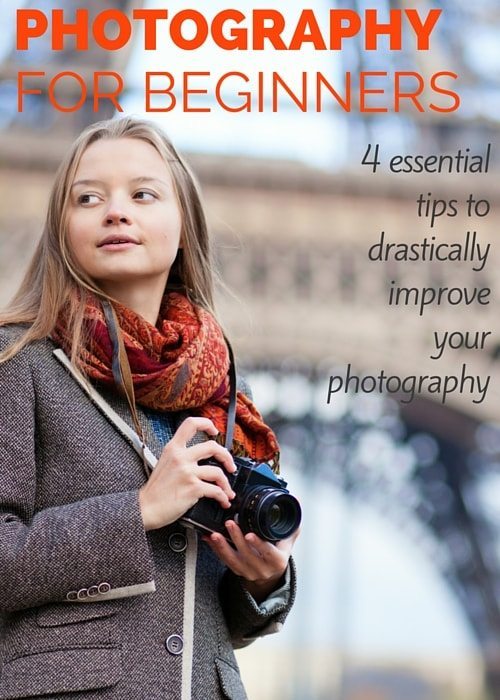Are you a budding photographer looking to make the move…
Photography For Beginners: 4 Essential Tips

As an adult it’s common to wish to pick up new skills as your tastes and interests change. Perhaps you thought it was a drag having to remember your French vocab lists in high school, whereas now you would relish the opportunity to learn some conversational French prior to a European holiday. And while a second language is a relatively common educational pursuit for adults, we would bet that a Photography for Beginners course would have even greater interest levels.
In years gone by most people didn’t even own a camera, and those that did usually only pulled them out once or twice a year on special occasions. These days, people carry high-tech cameras in their pockets and take (and share) photos on a daily basis. It’s just the way that technology and society have evolved, and many people wish that they could improve their photography skills to produce better photos.
The good news is that you don’t need to attend a Photography for Beginners course in order to improve your photography skills. Sometimes it’s as simple as picking up some fast photography tips that you can begin to implement immediately.
1. Know Your Camera

You know that annoying little booklet that got in your way while you were excitedly freeing your brand-new camera from its box? That’s the manual, and while our instinct (and modern day growing impatience) urges us to throw the manual away or hide it in a filing cabinet somewhere, the first step to becoming a better photographer is to actually read the manual that came with your camera. After all, you’ve paid a lot of money for all the special features that your camera offers, so you may as well learn how to use them. If you’re going to leave your fancy digital camera on auto mode, you’ll produce no better photos than if you used the camera built-in to your smart phone.
2. Broaden Your View

When taking photos, try not to solely view your subjects through your camera’s viewfinder. Stop regularly to take a step back and view your surroundings as a whole. While it can be tempting to focus in directly on your subjects, at the same time you may be missing an essential element of the scene just outside the frame. The subject of your photos doesn’t always need to be front and centre, and sometimes the most effective photography has the real subject of the photo to one side, with the rest of the frame setting the scene for the rest of the story.
3. The Rule of Thirds

By Ann Drake
If you’re looking for just one takeaway from this article, perhaps it could be to finally understand and know how to use the rule of thirds. The rule of thirds relates to the psychology of people when they are viewing images, and basically holds that every image can be divided into nine equal parts (imagine a 3 x 3 grid overlaid on an image), and that the elements of the image that are situated along the lines or at their intersections are going to be more pleasing to the viewers’ eye.
What does this mean for you? It means that you need to stop trying to centre the subject of your photo directly in the middle of your image. In fact, many cameras will have a “guidelines” option somewhere in the settings (remember when we suggested that you read the manual that came with your camera?), which will superimpose a 3 x 3 grid onto the viewfinder of your camera, allowing you to line up your images perfectly. In simple terms, enable the “guidelines” option on your camera, then position the subject of your photo so that they/it appears along one of the lines or at one of the intersections.
The rule of thirds doesn’t just apply to photography, but to all elements of design including art, architecture, and interior design, so it is an essential element of photography that can only benefit your resulting photographs.
4. Keep the End Result in Mind

Sometimes it’s not about creating the cleverest photographic effects, or using the best combination of lighting and props to create a masterpiece. Sometimes it’s simply about capturing a perfect moment in the best way you know how, without artificially manipulating the scene. Always keep in mind who the photo is for and what the end result is intended to be.
We once spoke with a mother who had taken her young daughter for a professional photo shoot. The little girl was very shy, and the mother was clear that she was simply hoping to come away with a natural-looking, happy photo of her daughter with her favourite soft toys. Unfortunately the photographers became a little overexcited and took over the photo session, overwhelming the little girl by dressing her up in various costumes and posing her with props, and insisting that the beloveds soft toys not appear in the photos (the mother did admit that the toys were a little old and raggedy). The end result was a series of photos that were technically very well composed, but were of no interest to the client. Her daughter was not comfortable in the elaborate costumes she had been dressed in, and was unhappy to have been separated from her toys. Her usual broad, easy smile was reduced to a nervous grimace. Had the photographers kept the end result in mind, they could have simplified their methods and focused on pure photography rather than manipulating the situation.
You don’t need to attend night school to improve your photography. Sometimes, it’s about taking a step back and looking at the situation as a whole. Take in your surroundings, and be clear with yourself about your intended end result rather than trying to step in and manipulate every photographic opportunity to your own end. After all, most people would agree that the best photography is exceedingly simple and has many natural elements to it. Now here’s your homework assignment: take at least one of these four tips and implement it in your photography, today. At the end of your photo shoot, choose your favourite image and print it on canvas as a reminder of how much your photography can be improved by making small changes to your methods or mindset.
Oh, and read the manual that came with your camera!



